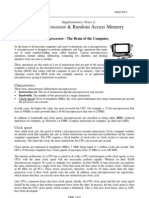Virtual Memory
Virtual Memory
Uploaded by
John Cliff BautistaCopyright:
Available Formats
Virtual Memory
Virtual Memory
Uploaded by
John Cliff BautistaOriginal Description:
Original Title
Copyright
Available Formats
Share this document
Did you find this document useful?
Is this content inappropriate?
Copyright:
Available Formats
Virtual Memory
Virtual Memory
Uploaded by
John Cliff BautistaCopyright:
Available Formats
What is virtual memory?
If your computer lacks the random access memory (RAM) needed to run a program or operation, Windows uses virtual memory to compensate. Virtual memory combines your computers RAM with temporary space on your hard disk. When RAM runs low, virtual memory moves data from RAM to a space called a paging file. Moving data to and from the paging file frees up RAM to complete its work. The more RAM your computer has, the faster your programs will generally run. If a lack of RAM is slowing your computer, you might be tempted to increase virtual memory to compensate. However, your computer can read data from RAM much more quickly than from a hard disk, so adding RAM is a better solution
Virtual memory is an operating system feature that was originally used to provide large usable address spaces for every process on machines that had very little physical memory. It is used by an operating system to fool1 a running process into believing that it can allocate a vast amount of memory for its own purposes, although whether it is allowed to or not depends on the operating system and the permissions of the individual user.
To facilitate copying virtual memory into real memory, the operating system divides virtual memory into pages, each of which contains a fixed number of addresses. Each page is stored on a disk until it is needed. When the page is needed, the operating system copies it from disk to main memory, translating the virtual addresses into real addresses. Virtual-real operation
In OS/VS1 and similar OSes, some parts of systems memory are managed in virtual-real mode, where every virtual address corresponds to a real address, specifically interrupt mechanisms, paging supervisor and tables in older systems, and application programs using non-standard I/O management. For example, IBM's z/OS has 3 modes (virtual-virtual, virtual-real and virtualfixed)
Memory Read operation Memory Read operation is carried out by first selecting the memory chip by activating the Memory Select signal. The Read signal is asserted to configure the memory circuitry for reading data from the memory. An address (100) is applied on the Address Lines. The internal address decoder of the memory decodes the address and selects one unique row from which data is read. Memory Write operation Memory Write operation is carried out by first selecting the memory chip by activating the Memory Select signal. The Write signal is asserted to configure the memory circuitry for writing data to the memory. An address (011) is placed on the Address Lines by the
microprocessor. The internal address decoder of the memory decodes the address and selects one unique row select line which selects the row location 3. The data (10110010) to be written to the selected memory location is placed on the external data bus by the microprocessor which is stored in the selected location.
You might also like
- Kariuki Ouma Ng'etich - Property Law Book - 2016Document518 pagesKariuki Ouma Ng'etich - Property Law Book - 2016Zakariya Mohamed82% (11)
- Workshop, Repair and Service Manuals, Wiring Diagrams, Fault Codes PDF - More Than 1000+ Truck Manuals Are Available For Free Download!Document12 pagesWorkshop, Repair and Service Manuals, Wiring Diagrams, Fault Codes PDF - More Than 1000+ Truck Manuals Are Available For Free Download!Anbarasan67% (3)
- J Nativememory Linux PDFDocument37 pagesJ Nativememory Linux PDFanguemar78No ratings yet
- Dynagraph Card AnalysisDocument4 pagesDynagraph Card AnalysisCedric Kimloaz100% (2)
- OS Ss1&2alex - Od (Copy)Document1 pageOS Ss1&2alex - Od (Copy)Mehari TemesgenNo ratings yet
- Registers, RAM and Cache MemoryDocument3 pagesRegisters, RAM and Cache MemoryGruNo ratings yet
- Virtual Memory (Computer Operating System)Document44 pagesVirtual Memory (Computer Operating System)Umera Anjum100% (1)
- Memory Organization in ComputerDocument9 pagesMemory Organization in ComputerR Junaid OmerNo ratings yet
- Ali Hamad Bakar Memory Management Devices: Par TicipantsDocument12 pagesAli Hamad Bakar Memory Management Devices: Par TicipantsAwatif MaisaraNo ratings yet
- MemoryDocument5 pagesMemoryfcmitcNo ratings yet
- Lovely Professional University: Computer Organization and ArchitectureDocument7 pagesLovely Professional University: Computer Organization and ArchitectureYogesh Verma YogiNo ratings yet
- Computer HardwareDocument21 pagesComputer HardwareDaniel EssienNo ratings yet
- Ayano .MicroprocessorassignmentDocument18 pagesAyano .MicroprocessorassignmentAyano BoresaNo ratings yet
- PC EngineeringDocument22 pagesPC Engineeringomnath tiwariNo ratings yet
- Primery and Secondary MemoriesDocument5 pagesPrimery and Secondary MemoriesFaheem MustafaNo ratings yet
- Memory Architecture and HierarchyCOA AssignmentDocument7 pagesMemory Architecture and HierarchyCOA AssignmentChang ShengNo ratings yet
- Memory Management Guide (1106)Document9 pagesMemory Management Guide (1106)roohmadi9430No ratings yet
- Different Types of ROMDocument5 pagesDifferent Types of ROMMaria Victoria FarrugiaNo ratings yet
- Lecture NotesDocument10 pagesLecture Notesibraheembello31No ratings yet
- Computer MemoryDocument5 pagesComputer MemorysetaraNo ratings yet
- Coa BlogDocument17 pagesCoa BlogA Zizi ZiziNo ratings yet
- Computer Organization and Architecture Unit MemoryDocument22 pagesComputer Organization and Architecture Unit MemoryKUNAL YADAVNo ratings yet
- Edo RamDocument14 pagesEdo RamMoses ImmanNo ratings yet
- Virtual Memory OverviewDocument4 pagesVirtual Memory Overviewmalikyasir1621No ratings yet
- Unit IIIDocument47 pagesUnit IIISakile ChinnuNo ratings yet
- Computer Memory Basics: RAM ROM CacheDocument6 pagesComputer Memory Basics: RAM ROM CacheAbubakker SiddiqNo ratings yet
- MemoryDocument6 pagesMemoryderry6271No ratings yet
- Virtual MemoryDocument8 pagesVirtual MemoryWeng HuiNo ratings yet
- What Are The Differences Between ROM and RAMDocument7 pagesWhat Are The Differences Between ROM and RAMCostasNo ratings yet
- Rom Ram RDocument10 pagesRom Ram RSul SyaNo ratings yet
- Computer MemoryDocument5 pagesComputer Memorynasironlineshoping001No ratings yet
- Microprocessor & Random Access MemoryDocument4 pagesMicroprocessor & Random Access MemoryWaleed AnjumNo ratings yet
- Virtual MemoryDocument13 pagesVirtual MemoryHira KhyzerNo ratings yet
- Virtual Memory and Memory Management Requirement: Presented By: Ankit Sharma Nitesh Pandey Manish KumarDocument32 pagesVirtual Memory and Memory Management Requirement: Presented By: Ankit Sharma Nitesh Pandey Manish KumarAnkit SinghNo ratings yet
- Virtual MemoryDocument7 pagesVirtual Memorydevank1505No ratings yet
- Memory Unit: Types of Primary MemoryDocument3 pagesMemory Unit: Types of Primary MemoryNadesh Chithambaram PillaiNo ratings yet
- Computer PresentationDocument14 pagesComputer PresentationAayush Niroula OfficialNo ratings yet
- How Computer Memory Works-HowstuffsworkDocument6 pagesHow Computer Memory Works-HowstuffsworkLogeswari GovindarajuNo ratings yet
- Ram and Rom CalculationsDocument23 pagesRam and Rom Calculationsezekiel nyamuNo ratings yet
- System Material 3Document10 pagesSystem Material 3Suhas V100% (1)
- Ram TutorialDocument26 pagesRam TutorialGiannis PapanikolopoulosNo ratings yet
- Lesson 6Document15 pagesLesson 6elvindadashov032No ratings yet
- MemoryDocument5 pagesMemoryKanika DarochNo ratings yet
- Why Is There A Need For Virtual Memory?: R: ET/COE/ND/19/003 Cousre: Cte 214 D: 6 S 2021Document4 pagesWhy Is There A Need For Virtual Memory?: R: ET/COE/ND/19/003 Cousre: Cte 214 D: 6 S 2021JosephishakuNo ratings yet
- Difference Between RAM and ROMDocument7 pagesDifference Between RAM and ROMJan Carlo Balatan Pablo100% (2)
- Computer BasicsDocument18 pagesComputer Basicsmehar_rezaNo ratings yet
- Types of Main Memory (Primary Memory) : 1-Read Only Memories (ROM)Document7 pagesTypes of Main Memory (Primary Memory) : 1-Read Only Memories (ROM)pranavsaigoud1No ratings yet
- How Computer Memory WorksDocument6 pagesHow Computer Memory WorksToon ManNo ratings yet
- REG: ET/COE/ND/19/009 Course: Cte 214 Date: 3 SEP. 2021: What Is Virtual Memory?Document4 pagesREG: ET/COE/ND/19/009 Course: Cte 214 Date: 3 SEP. 2021: What Is Virtual Memory?JosephishakuNo ratings yet
- Storage DevicesDocument11 pagesStorage DevicesHuma aliNo ratings yet
- MemoryDocument6 pagesMemorykevinkingili450No ratings yet
- Chapter 2 COM101Document5 pagesChapter 2 COM101Christean Val Bayani ValezaNo ratings yet
- Intro To Computer AyazDocument6 pagesIntro To Computer Ayazجمہوری جنانNo ratings yet
- RAM MemoryDocument40 pagesRAM MemoryAndre Deyniel CabreraNo ratings yet
- Types of RAM: Cache CapacitorDocument7 pagesTypes of RAM: Cache CapacitorelgherianyNo ratings yet
- Introduction To How Computer Memory WorksDocument4 pagesIntroduction To How Computer Memory WorksEthan GabrielNo ratings yet
- Module 5Document66 pagesModule 5Ananya P.SNo ratings yet
- Real and Virtual MemoryDocument2 pagesReal and Virtual Memoryprofessor_manojNo ratings yet
- Week 5Document11 pagesWeek 5BWENGYE JUSTUSNo ratings yet
- Chapter 3Document8 pagesChapter 3HeinNo ratings yet
- CC C CCC ! "#!$%Document28 pagesCC C CCC ! "#!$%Suresh PatelNo ratings yet
- SAS Programming Guidelines Interview Questions You'll Most Likely Be AskedFrom EverandSAS Programming Guidelines Interview Questions You'll Most Likely Be AskedNo ratings yet
- English Activity Sheet: Quarter 2 - MELC 3Document11 pagesEnglish Activity Sheet: Quarter 2 - MELC 3Tipa JacoNo ratings yet
- Green Marketing by Body Shop FinalDocument24 pagesGreen Marketing by Body Shop FinalSurya Banerjee100% (2)
- Introduction To Wing DesignDocument9 pagesIntroduction To Wing DesignJef LeNo ratings yet
- The Importance of Data-Based Decision Making: VignetteDocument11 pagesThe Importance of Data-Based Decision Making: VignetteJoviner Yabres LactamNo ratings yet
- Chemical Resistance GB 0612Document2 pagesChemical Resistance GB 0612Gonza Carnevale0% (1)
- Butylscopolamine - Br. J. Anaesth.-2013-Ryu-932-7Document6 pagesButylscopolamine - Br. J. Anaesth.-2013-Ryu-932-7MIRELA MIHALACHINo ratings yet
- Daylight Analysis in Hostel BlockDocument7 pagesDaylight Analysis in Hostel Blocksonal sonal100% (1)
- Assignment Problems PDFDocument3 pagesAssignment Problems PDFjaoceelectricalNo ratings yet
- EXTRAJUDICIAL SETTLEMENT W. WAIVER OF RIGHTS Onofre PaguiaDocument4 pagesEXTRAJUDICIAL SETTLEMENT W. WAIVER OF RIGHTS Onofre PaguiaJorge M. GarciaNo ratings yet
- Annex e To Multi Part Advisory Circular 119 11 and 138 2Document8 pagesAnnex e To Multi Part Advisory Circular 119 11 and 138 2Beka KarumidzeNo ratings yet
- Ias-33 EpsDocument59 pagesIas-33 Epssyed asim shahNo ratings yet
- Pre-Spud Checklist # 4Document2 pagesPre-Spud Checklist # 4Yougchu LuanNo ratings yet
- Managing The Marketing Function SHERWIN ESPIRITUDocument35 pagesManaging The Marketing Function SHERWIN ESPIRITUangelo95% (20)
- PromotionLetter 202005A027561Document2 pagesPromotionLetter 202005A027561vicky sam ka keiNo ratings yet
- Automated LPG Cylinder Monitoring SystemDocument6 pagesAutomated LPG Cylinder Monitoring Systemolivia.edu888No ratings yet
- The Alarm Company ActDocument35 pagesThe Alarm Company ActSudeep TrNo ratings yet
- Representing Linear Systems With Matrices (Article) - Khan AcademyDocument12 pagesRepresenting Linear Systems With Matrices (Article) - Khan AcademyAshekin MahadiNo ratings yet
- At-Home Activities For Preschool and Pre-KDocument5 pagesAt-Home Activities For Preschool and Pre-KioaNo ratings yet
- Case Studi Organizational BehaviourDocument9 pagesCase Studi Organizational BehaviourNita YunitasariNo ratings yet
- Sigma Coating BrochureDocument12 pagesSigma Coating BrochuresatyandaruNo ratings yet
- Muhamma D Asim: ObjectiveDocument2 pagesMuhamma D Asim: ObjectiveMuzaffar HussainNo ratings yet
- DraftPrint RHQLegacyDocument2 pagesDraftPrint RHQLegacyPrince KumarNo ratings yet
- Citi Bank Case AssignmentDocument7 pagesCiti Bank Case AssignmentFun Toosh345No ratings yet
- ENG-PST Lecture2Document25 pagesENG-PST Lecture2Abdulrahman AlhomsiNo ratings yet
- Falconfx Strategy Handbook v2pdfDocument38 pagesFalconfx Strategy Handbook v2pdfPerfecto View100% (1)
- BASF-Automotive Innovation PipelineDocument62 pagesBASF-Automotive Innovation Pipelinepisisler31No ratings yet
- Marketing Management Book - 1Document328 pagesMarketing Management Book - 1sameerkh2305No ratings yet

























































































